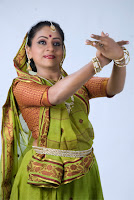Today [5th July 2020] is ‘Guru
Purnima’ (Full moon day dedicated to all Guru’s). The word Guru is derived from
two Sanskrit words ‘Gu’ meaning ‘darkness ‘or ignorance and ‘Ru’ meaning
removal. Hence a Guru is one who removes darkness from our lives. In Indian classical
dance, we follow ‘Guru Shishya Parampara’ (Master and disciple tradition). On
this auspicious day of ‘Guru Purnima’ all the Indian classical dancers offer
puja (worship) to their gurus and seek their blessings. On this special occasion
of ‘Guru Purnima’ I want to dedicate my blog to my dance Guru Mukta Joshi ji.
My guru Mukta Joshi ji is a leading
exponent of Indian classical dance form Kathak (Jaipur style). She is a famous
Kathak dance guru and choreographer and the founder of ‘Nrityadhara Kathak Research
Institute’. She has performed in dance festivals held in various countries
across the globe like USA, Korea, Vietnam, Mauritius, China etc. She has received several awards.
I am
sharing with you some excerpts of the interview that my Guru Mukta Joshi ji gave me about
her dance journey and her vision for the future:
Q- When did you start learning Kathak?
What inspired you to learn Kathak?
A- I started learning Kathak when I was in grade
10. My sister is a singer and my father played sitar and violin. So, I was
exposed to classical music since an early age which led me to developing an
interest in Indian Classical programs. Since I had an interest in Kathak dance
form I decided to learn it.
Q- Please tell me about your ‘gurus’
under whose guidance you have learnt this dance form?
A- I took my initial lessons of kathak from my
first guru Dr. K Rajkumar and in 1988 I completed ‘Nrityalankar’ titled degree
exam of Gandharva Mandal Miraj under his guidance. However, I slowly realised
that his style was masculine and was not quite aligned with my thinking. So,
I consulted him and joined Dr. Padmashri Roshan Kumari ji. Till today, under
her guidance I am taking lessons of pure Jaipur style of Kathak.
Q- Can you tell me more about your
‘guru’ Dr. Roshan Kumari ji?
A- My guru Dr. Roshan Kumari ji is India’s leading exponent of Kathak dance of the
Jaipur gharana. Her gurus were Shri K.S. Moray, Pandit Sunder Prasad, Gulam
Hussain Khan of Patiala and Hanuman Prasad. On 24th March 1984, Dr
Roshan Kumari was awarded the Padmashree title by the President of India. In
the XXII All India Music conference held in 1963, the Prayagraj Sangeet Samiti,
Allahabad awarded the title of ‘Nritya-Shiromani’ to her. She is also running a
kathak dance Academy called ‘Nritya Kala Kendra’ in Mumbai since 1971.
Q- According to you why should one
learn Kathak?
A- Our forefathers developed knowledge of the Indian dance culture
after many years of deep study, but the objective of learning Kathak is not
just limited to preserving the Indian culture. Kathak dance is a form of
worship that provides us with mental peace. It is a devotion towards God.
Kathak has the strength of making the dancer forget his/her body movements and
engage in spiritual bliss. While doing fast movements and footwork in Kathak,
the dancer gains a better control over their body which also helps to enrich
self-confidence.
Q- When did you decide to start your
own institute of Kathak- ‘Nrityadhara’?
A- I founded ‘Nrityadhara’ in 1988. ‘Nrityadhara’ is an institute dedicated
to the Indian classical dance Kathak and to the folk culture of India. I
founded this institute with the aim of promoting dance, music and performing
arts.
Q- Can you tell
me more about the activities conducted by ‘Nrityadhara’?
A- ‘Nrityadhara’ conducts several activities for promotion of Kathak dance
and Indian music such as lectures, demonstrations, annual workshops and stage
performances of senior and experienced artists. Besides, ‘Nrityadhara’
organises stage programmes for budding dancers to build their confidence. Every
year the ‘Guru Poornima Utsav’ is celebrated by ‘Nrityadhara’ in which even the
younger dancers are encouraged to present their dances. The aim of
‘Nrityadhara’ is to promote Indian classical and folk tradition not only by
representing it but also by studying it from different angles. For achieving
this purpose ‘Nrityadhara’ registered with the government by the name of
‘Nrityadhara’ Kathak Research Institute’ in the year 2002.
Q- Do you
have any message for younger artists?
A- Under the overwhelming influence of modernization and westernization all
Indian classical art forms are fighting for survival. Kathak is no exception.
It is the duty of every Kathak practitioner to re-establish the glory of this
ancient classical dance. I aim to involve more and more young minds and talents
to spread awareness about Kathak through practice and performance.

Hello. I have very much enjoyed going back through the posts in your blog during the past couple of days. Why didn't I know about this before? It is very informative and often nicely written.
ReplyDeleteAmong other posts, it was nice to find that you did one on Mukta Joshi - and very nice to see that she is your guru! I did a little writing about her in my WordPress blog, Dances on the Footpath, back in 2017. This was in relation to Roshan Kumari, whom I have written quite a few posts about in my blog for quite a few years. Here's the link to that post:
https://roughinhere.wordpress.com/2017/08/29/very-interesting-newly-found-videos-related-to-roshan-kumari/
And by the way, did you know that December 24 is Roshan Kumari's birthday? :)
Anyway, I hope you will do more posts on this blog soon!